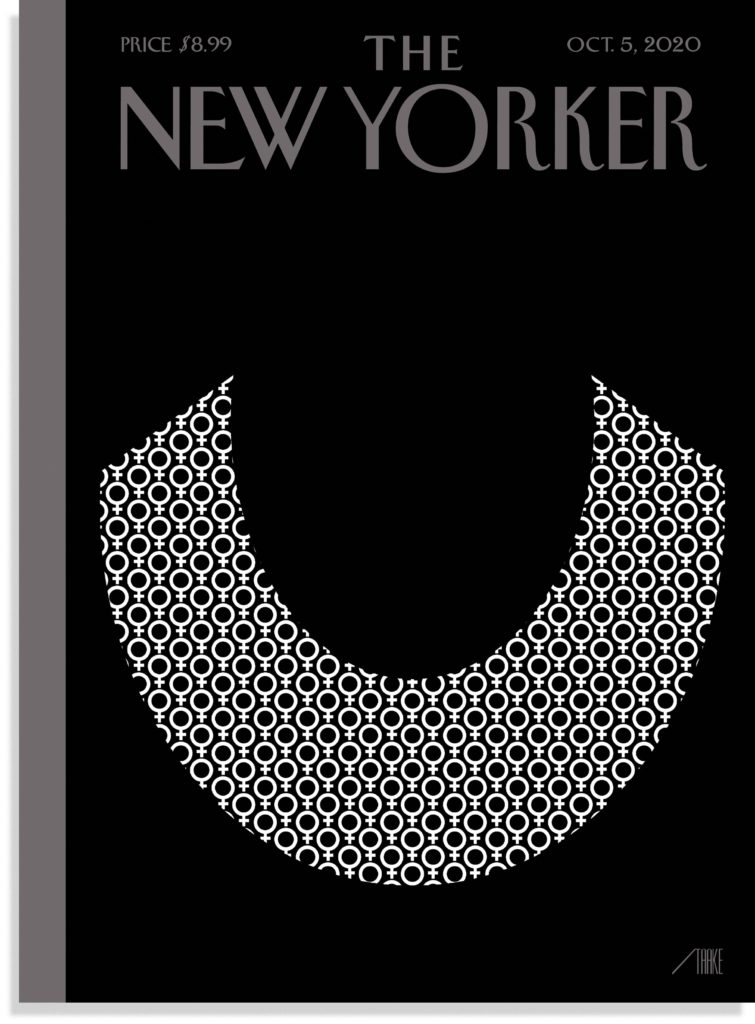
No words are needed to convey the powerful icon, legacy and reform Ruth Bader Ginsburg left behind with us last week. After a tenure of 27 years on the supreme court, we have her to thank for advancing women’s rights and pay in the workplace, the right to marry anyone regardless of sex, the ability to get an abortion, equal social security survivor benefits and women’s access to credit cards and a mortgage (Pinsker, 2020).
The collar, however, remains a pop-culture icon; they are buyable in jewelry, clothing and costume form (Friedman, 2020). Each one in her collection was meant to symbolize an opinion; the yellow jabot in agreement for majority opinion and the famous collar with the spiked beading for dissent, among many others (Foussianes, 2020). What started as a celebration of femininity within a male dominated court, her approach to communicating equality under the law has taken on a more wide, marketable symbol. Each collar took on its own meaning and message before Justice Ginsburg even spoke (Friedman, 2020), ushering a new level to personal and therefore, political branding. Since political branding via imagery, symbols and mass communication fosters trust in constituencies who vote, it’s imperative that these symbols be transparent and tell a powerful story (Edelman, 1964). The symbol can therefore sway public opinion and as a result, change voters’ decisions.
The dissent collar in necklace form is currently buyable on Banana Republic’s website, with 50% of the proceeds going to the ACLU Women’s Rights Projects. Citizens wore versions of the collar during multiple women’s marches across the country (Tschorn, 2020). In 2018 when the documentary about her life came out, the poster revealed just a clip of her portrait and the yellow collar to match her initials: RBG. After the 2016 election results, RBG was seen wearing her dissent collar even though there were no hearings that day. The powerful message behind such a popular symbol has taken on a life of its own. Just like the pink hats during women’s marches, an upright fist to symbolize the Black Lives Matter movement, LGBT symbols like the rainbow flag, a group will rally behind their symbol in solidarity for their ideologies. It’s a simple way to communicate a powerful message.
Deshpande & Keinan (2014) discuss six criteria for brand elements such as a logo, slogan or symbol. They should be memorable, meaningful, likeable, transferable, adaptable and protectable (Deshpande & Keinan, 2014). The collars are certainly memorable and carry heavy meaning behind each one. They are transferable and adaptable to fit the message RBG wanted to articulate. Worldwide, everyone knows what the collar stands for; this identification proves the collar’s usefulness as a tool to reflect change, justice, and shifts in social and collective thought as America struggles with her own identity.
The question begs, however, where will the symbol go from here? Will RBG’s laced logo remain in history as a statement of our times, much like the peace symbol during the Vietnam war or Rosie the Riveter during WWII? Or will the collar grow beyond current events and evolve, becoming a rallying call for collective action as we race towards election day and change our path of history?
References:
Deshpande, R., & Keinan, A. (2014). Brand and Brand Equity. Harvard Business Review.
Edelman, M. (1964). The Symbolic Uses of Politics. Illinois: Illinois University Press.
Foussianes, C. (2020, Sep 19). Ruth Bader Ginsburg’s Collars Decoded: What Each Neckpiece Means. Town and Country Magazine. Retrieved from https://www.townandcountrymag.com/society/politics/a25362496/ruth-bader-ginsburg-collar-meaning/
Friedman, V. (2020, Sep 20). Ruth Bader Ginsburg’s Lace Collar Wasn’t an Accessory, It Was a Gauntlet. The New York Times. Retrieved from https://www.nytimes.com/2020/09/20/style/rbg-style.html
Pinsker, J. (2020, Sep 23). RBG’s Fingerprints Are All Over Your Everyday Life. The Atlantic. Retrieved from https://www.theatlantic.com/family/archive/2020/09/ruth-bader-ginsburg-legacy/616447/
Tschorn, A. (2020, Sep 23). Ruth Bader Ginsburg’s coded collars taught us that the little things matter. The Los Angeles Times. Retrieved from https://www.latimes.com/lifestyle/story/2020-09-23/life-lessons-ruth-bader-ginsburg-collars

7 Responses to Rebranding America: Dissent, reform and the power of RBG’s image